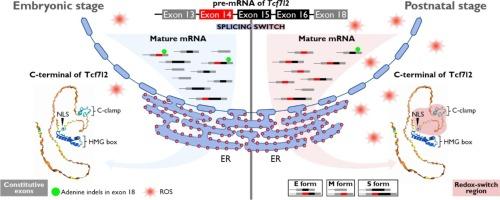小鼠心脏发育过程中t细胞因子7l2的异构体开关
IF 2.2
Journal of molecular and cellular cardiology plus
Pub Date : 2025-06-01
DOI:10.1016/j.jmccpl.2025.100458
引用次数: 0
摘要
典型的WNT信号在心脏发育和疾病中起着关键的,通常是相反的作用,但其上下文依赖的机制尚不清楚。我们假设β-catenin的关键核伴侣Tcf7l2的选择性剪接有助于心脏中WNT信号的特异性。为了研究这一点,我们克隆并测序了胚胎17.5天(E17.5, 24/53)和出生后第8天(P8, 29/53)小鼠心室组织中的53个Tcf7l2转录本,鉴定了32个不同的亚型。在18个潜在外显子中,外显子6和17缺失,超过80%的转录本缺乏外显子4。选择性剪接在c端外显子(14、15和16)中很突出,P8心脏的外显子14包含率(64.3%)显著高于E17.5心脏(34.8%)。外显子15和16组合的变化,以及由靠近外显子18开头的腺嘌呤插入和缺失(indel)引起的阅读框移位,影响了c端结构,改变了E-tail、C-clamp和ctbp结合基序的存在。值得注意的是,外显子14的插入在E和S异构体中引入了一个跨越NLS和C-clamp区域的氧化还原开关结构域,而腺嘌呤插入改变了异构体的长度,驱动了E、S和M异构体之间的转换。跨多个发育阶段的RT-PCR验证证实了这些剪接模式。我们的研究结果表明,Tcf7l2的出生后氧化还原敏感异构体开关调节WNT信号,可能影响心肌细胞从增殖到肥大转变过程中的成熟。本文章由计算机程序翻译,如有差异,请以英文原文为准。

Isoform switch of T-cell factor7L2 during mouse heart development
Canonical WNT signaling plays critical, often opposing roles in heart development and disease, but its context-dependent mechanisms remain unclear. We hypothesized that alternative splicing of Tcf7l2, a key nuclear partner of β-catenin, contributes to WNT signaling specificity in the heart. To investigate this, we cloned and sequenced 53 Tcf7l2 transcripts in ventricular tissues from embryonic day 17.5 (E17.5, 24/53) and postnatal day 8 (P8, 29/53) mice, identifying 32 distinct isoforms. Among 18 potential exons, exons 6 and 17 were absent, and over 80 % of transcripts lacked exon 4. Alternative splicing was prominent in the C-terminal exons (14, 15, and 16), with exon 14 inclusion significantly higher in P8 hearts (64.3 %) than E17.5 hearts (34.8 %). Variations in exon 15 and 16 combinations, along with reading frame shifts caused by the adenine insertion and deletion (indel) near the beginning of exon 18, affected C-terminal structures, altering the presence of the E-tail, C-clamp, and CtBP-binding motifs. Notably, exon 14 insertion introduced a redox-switch domain spanning the NLS and C-clamp regions in E and S isoforms, while adenine indels altered isoform lengths, driving transitions between E, S, and M isoforms. RT-PCR validation across multiple developmental stages confirmed these splicing patterns. Our findings suggest that a postnatal redox-sensitive isoform switch in Tcf7l2 modulates WNT signaling, potentially influencing cardiomyocyte maturation during the transition from proliferation to hypertrophy.
求助全文
通过发布文献求助,成功后即可免费获取论文全文。
去求助
来源期刊

Journal of molecular and cellular cardiology plus
Cardiology and Cardiovascular Medicine
自引率
0.00%
发文量
0
审稿时长
31 days
 求助内容:
求助内容: 应助结果提醒方式:
应助结果提醒方式:


